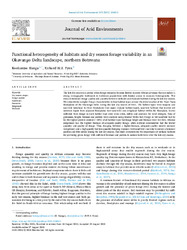Functional heterogeneity of habitats and dry season forage variability in an Okavango Delta landscape, northern Botswana.
Abstract
The late dry season is a period when forage resources become limited in some African savannas that can induce a strong demographic bottleneck in herbivore populations with limited access to resource heterogeneity. This study determined forage quality and quantity between wetlands and drylands habitats during the late dry season. We subjectively sampled forage characteristics in four habitat types around the distal reaches of the Tsum Tsum floodplains of the Okavango Delta during the late dry season of 2015. The habitat types were mopane and sandveld woodland far from floodplains (two major dryland habitat types), sandveld habitats that receive soil moisture inputs from adjacent floodplains (wet sandveld) and sedgeland habitat within the floodplain. Leaves collected from forage in each habitat type were oven dried, milled and analysed for total nitrogen. Data of greenness, height, biomass and protein were analysed using Kruskal-Wallis test. Forage in wet sandveld had by far the highest protein content (~16%) of all habitat types but forage height and biomass were very low, whereas sedgelands had the highest biomass of adequate-quality forage, while dryland communities had the lowest quantity and quality of forage. Thus, foraging between a higher-biomass, adequate-quality reserve resource (sedgeland) and a high-quality but low-quantity bridging resource (wet sandveld) can help to ensure a balanced protein and fibre intake during the late dry season. Our study demonstrated the importance of wetland habitats for providing green forage with sufficient biomass and protein to sustain herbivores over the late dry season.
Collections
- Research articles [88]

